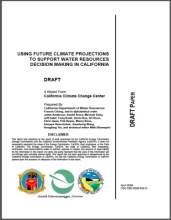Using future climate projections to support water resources decision making in California, California Energy Commission Technical Report

One of the challenges facing California’s water planners is how to assess the possible effects of
climate change, such as changes in rainfall and snowfall patterns, snowpack, runoff volume and
timing, sea levels, and urban and agricultural water demands. This paper presents several
advances in using future climate projection information in water resources planning, such as an
improved understanding of how well selected climate models represent historical climate
conditions and refined methodologies for representing streamflows, outdoor urban and
agricultural water demands, and sea level rise in planning tools. Twelve climate projections
were used to assess the future reliability of California’s main water supply projects. Midcentury
and end‐of‐the‐century impacts were estimated for Sacramento‐San Joaquin Delta
exports, reservoir carryover storage, groundwater pumping, power supply, and the Delta
salinity standard known as X2. The vulnerability of the system to operational interruption was
also examined. A sensitivity analysis was also conducted to examine the effects of air
temperature on runoff in the Upper Feather River basin, the main inflow source to Lake
Oroville. The range of impacts presented in this paper indicates a need to explore adaptation
measures to improve the reliability of future water supplies in California.
Chung, F., Anderson, J., Arora, S., Ejeta, M., Galef, J., Kadir, T., Kao, K., Olson, A., Quan, C., Reyes, E., Roos, M., Seneviratne, S., Wang, J., Yin, H., Blomquist, N., 2009. Using future climate projections to support water resources decision making in California, California Energy Commission Technical Report CEC-500-2009-052-F, August 2009.
